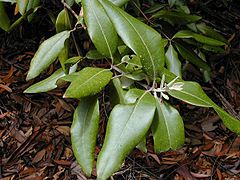Syncarpia glomulifera: Difference between revisions
No edit summary |
No edit summary |
||
| Line 1: | Line 1: | ||
{{SPlantbox | {{SPlantbox | ||
|familia=Myrtaceae | |familia=Myrtaceae | ||
|genus=Syncarpia | |genus=Syncarpia | ||
|species=glomulifera | |species=glomulifera | ||
|common_name=Turpentine | |common_name=Turpentine | ||
|name_ref=Flora - A Gardener's Encyclopedia | |name_ref=Flora - A Gardener's Encyclopedia | ||
| Line 25: | Line 25: | ||
|usda_ref=Flora - A Gardener's Encyclopedia | |usda_ref=Flora - A Gardener's Encyclopedia | ||
|max_zone=12 | |max_zone=12 | ||
|image= | |image=Syncarpia glomulifera1.jpg | ||
|image_width=240 | |image_width=240 | ||
}} | }} | ||
'''''Syncarpia glomulifera''''' ('''Turpentine''') is a tree native to [[New South Wales]] and [[Queensland]] in [[Australia]], which can grow to more than 30 metres in height. | |||
Formerly known as ''Syncarpia laurifolia'' Ten., it is one of the dominant species of the critically endangered [[Sydney Turpentine-Ironbark Forest]] ecological community. | |||
{{Inc| | {{Inc| | ||
Syncarpia glomulifera, Niedenzu (S. laurifolia, Ten.). Turpentine Tree. Lvs. broadly ovate to elliptic-oblong, obtuse or obtusely acuminate, 2-3 in. long, often appearing as if in whorls of 4: fls. 6-10 in a head, with 2-4 bracts of variable size under the head; calices connate at the base; petals broadly ovate or orbicular, less than 2 lines long; ovary 3-loculed; ovules several to each locule.—According to Von Mueller's Select Extra-tropical Plants, this tree attains a height of 200 ft., with a trunk often 30 ft. in circumference; it is of quick growth and well adapted for a shade tree. The wood is very durable and almost fireproof and is valuable for piles, railway sleepers, and shipbuilding. It takes a high polish and is used for flooring and cabinetwork. Offered in S. Calif. | Syncarpia glomulifera, Niedenzu (S. laurifolia, Ten.). Turpentine Tree. Lvs. broadly ovate to elliptic-oblong, obtuse or obtusely acuminate, 2-3 in. long, often appearing as if in whorls of 4: fls. 6-10 in a head, with 2-4 bracts of variable size under the head; calices connate at the base; petals broadly ovate or orbicular, less than 2 lines long; ovary 3-loculed; ovules several to each locule.—According to Von Mueller's Select Extra-tropical Plants, this tree attains a height of 200 ft., with a trunk often 30 ft. in circumference; it is of quick growth and well adapted for a shade tree. The wood is very durable and almost fireproof and is valuable for piles, railway sleepers, and shipbuilding. It takes a high polish and is used for flooring and cabinetwork. Offered in S. Calif. | ||
{{SCH}} | {{SCH}} | ||
| Line 65: | Line 38: | ||
==Cultivation== | ==Cultivation== | ||
===Propagation=== | ===Propagation=== | ||
===Pests and diseases=== | ===Pests and diseases=== | ||
== | |||
==Varieties== | |||
==Gallery== | ==Gallery== | ||
<gallery perrow=5> | |||
<gallery> | |||
Image:Upload.png| photo 1 | Image:Upload.png| photo 1 | ||
Image:Upload.png| photo 2 | Image:Upload.png| photo 2 | ||
| Line 86: | Line 57: | ||
==References== | ==References== | ||
<references/> | |||
<!--- xxxxx *Flora: The Gardener's Bible, by Sean Hogan. Global Book Publishing, 2003. ISBN 0881925381 --> | <!--- xxxxx *Flora: The Gardener's Bible, by Sean Hogan. Global Book Publishing, 2003. ISBN 0881925381 --> | ||
<!--- xxxxx *American Horticultural Society: A-Z Encyclopedia of Garden Plants, by Christopher Brickell, Judith D. Zuk. 1996. ISBN 0789419432 --> | <!--- xxxxx *American Horticultural Society: A-Z Encyclopedia of Garden Plants, by Christopher Brickell, Judith D. Zuk. 1996. ISBN 0789419432 --> | ||
| Line 95: | Line 66: | ||
{{stub}} | {{stub}} | ||
__NOTOC__ | |||
Latest revision as of 20:55, 22 June 2010
| Syncarpia glomulifera subsp. var. | Turpentine | |||||||||||||||||||||||||||||||||||||||||||||||||||||||
|---|---|---|---|---|---|---|---|---|---|---|---|---|---|---|---|---|---|---|---|---|---|---|---|---|---|---|---|---|---|---|---|---|---|---|---|---|---|---|---|---|---|---|---|---|---|---|---|---|---|---|---|---|---|---|---|---|

|
|
| ||||||||||||||||||||||||||||||||||||||||||||||||||||||
| ||||||||||||||||||||||||||||||||||||||||||||||||||||||||
Syncarpia glomulifera (Turpentine) is a tree native to New South Wales and Queensland in Australia, which can grow to more than 30 metres in height.
Formerly known as Syncarpia laurifolia Ten., it is one of the dominant species of the critically endangered Sydney Turpentine-Ironbark Forest ecological community.
| Standard Cyclopedia of Horticulture |
|---|
|
Syncarpia glomulifera, Niedenzu (S. laurifolia, Ten.). Turpentine Tree. Lvs. broadly ovate to elliptic-oblong, obtuse or obtusely acuminate, 2-3 in. long, often appearing as if in whorls of 4: fls. 6-10 in a head, with 2-4 bracts of variable size under the head; calices connate at the base; petals broadly ovate or orbicular, less than 2 lines long; ovary 3-loculed; ovules several to each locule.—According to Von Mueller's Select Extra-tropical Plants, this tree attains a height of 200 ft., with a trunk often 30 ft. in circumference; it is of quick growth and well adapted for a shade tree. The wood is very durable and almost fireproof and is valuable for piles, railway sleepers, and shipbuilding. It takes a high polish and is used for flooring and cabinetwork. Offered in S. Calif. CH
|
Cultivation
Propagation
Pests and diseases
Varieties
Gallery
-
photo 1
-
photo 2
-
photo 3
References
External links
- w:Syncarpia glomulifera. Some of the material on this page may be from Wikipedia, under the Creative Commons license.
- Syncarpia glomulifera QR Code (Size 50, 100, 200, 500)
